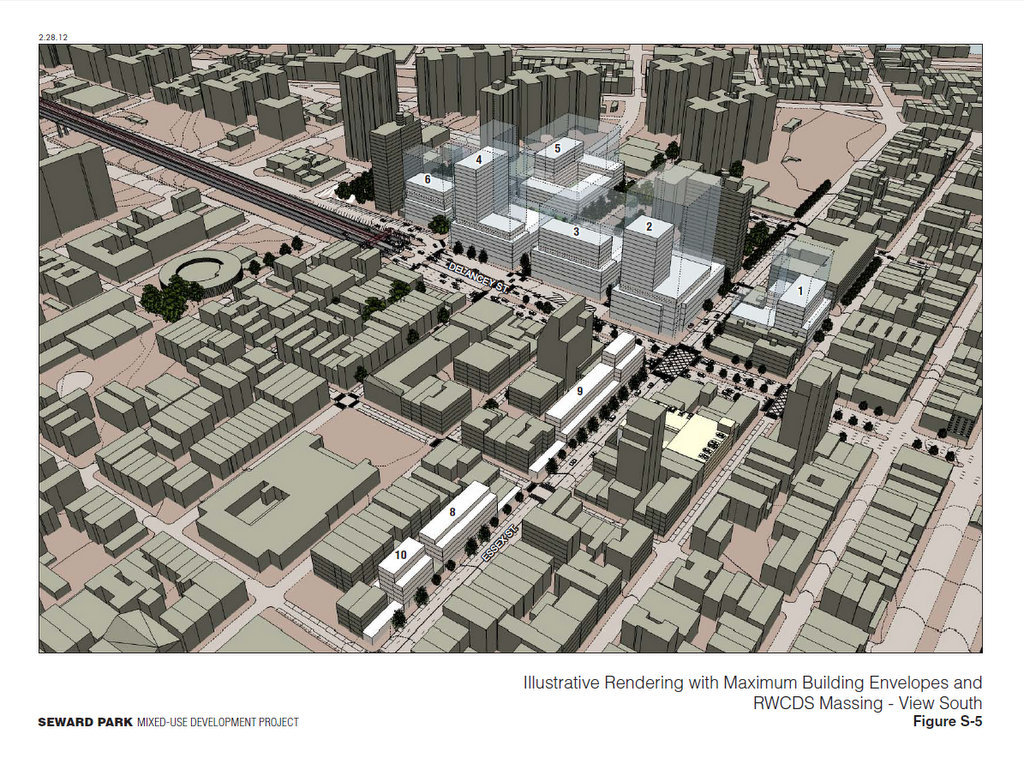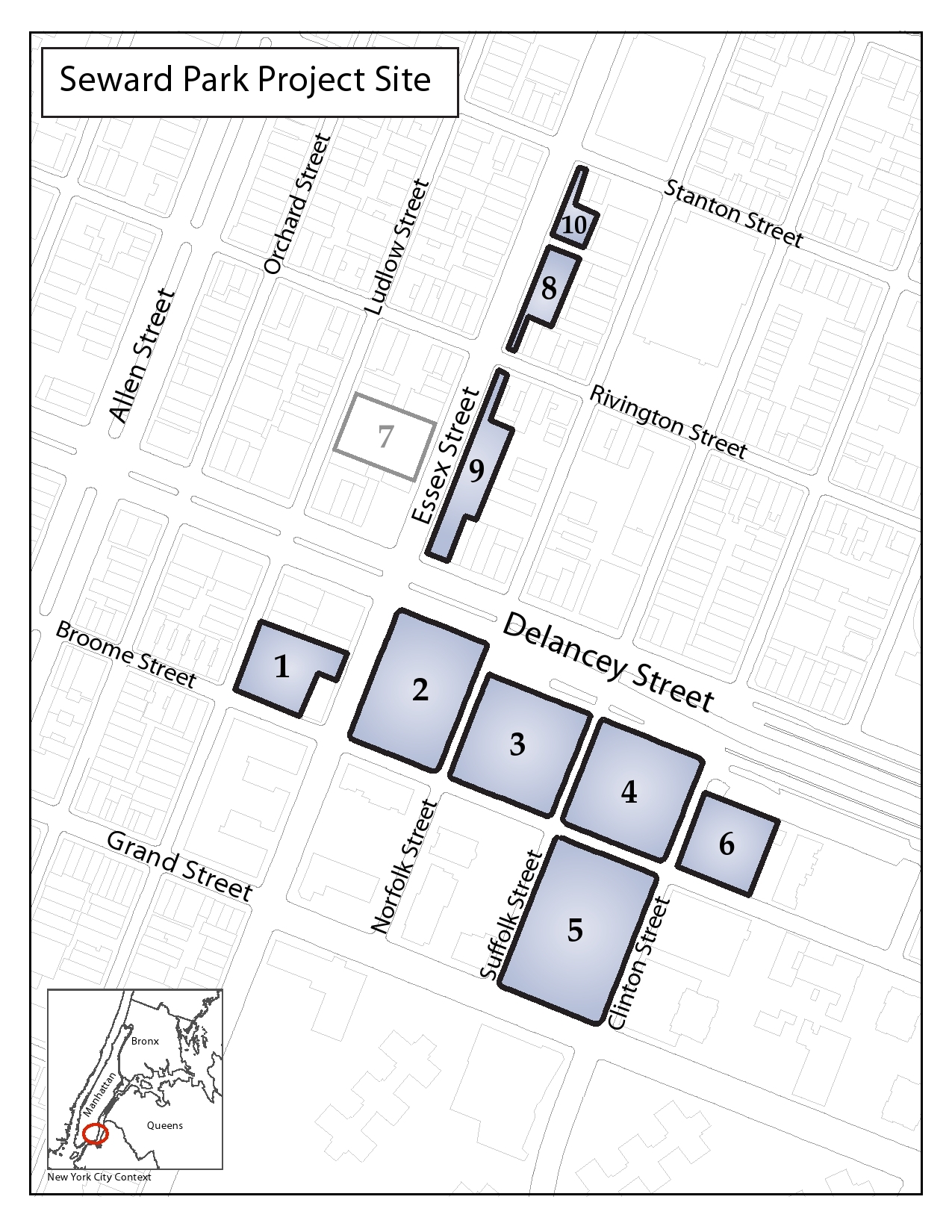The City agreed to increase number of housing units from 900 to 1,000 and set aside space for on-site public school. On October 11, 2012 the City Council modified and approved the City’s Seward Park Mixed-Use Development Project. The 1.65 million-square-foot project will impact nine City-owned lots on the north and south sides of Delancey Street between Ludlow and Clinton Streets in Manhattan’s Lower East Side. The City envisions the development of six new mixed-use buildings, 500 underground public parking spaces, and the potential relocation of the Essex Street Market to a large space on the south side of Delancey. As initially proposed, the project would create 900 residential units, 450 of which would affordable for low-, moderate-, and middle-income tenants. The Economic Development Corporation, which is the authorized representative for the multi-agency effort, has not identified a developer, but plans to issue a formal request for proposals in January 2013.
A portion of the project site was part of the 1965 Seward Park Extension Urban Renewal Area (SPEURA) plan, which sought to replace overcrowded and unsafe tenements with low-income housing developments. SPEURA expired in 2005, and although the City redeveloped portions of SPEURA, the majority of the lots remained vacant and have been used as parking for 30 years. In 2008, the City and Lower East Side community began work on the Seward Park Mixed-Use Development Project.
At the City Planning Commission’s public hearing in July 2012, both those in support of, and those opposed to, the proposal recommended changes to the plan’s affordable housing component. Representatives from Manhattan Community Board 3, which broadly supported the proposal, asked the City to make the subsidized housing permanently affordable. Other community groups, opposed to the plan, argued that 100 percent of the project’s housing should be permanently affordable. These groups also requested that the City set aside space for community facility uses, such as a public school and a health clinic. The Planning Commission in August 2012 approved the proposal without modifications. (See CityLand’s past coverage here.)
At the Council’s Planning, Dispositions & Concessions Subcommittee hearing on September 19, 2012, local community groups reiterated their concerns about the proposal. Local Council Member Margaret Chin echoed the community’s concerns about the amount of affordable housing, and urged the City to dedicate space for an on-site public school. Council Member Chin expressed concerns about the project’s impact on small business opportunities and how relocating the Essex Street Market would affect existing tenants. Alyssa Konon, an executive vice president at EDC, testified that the proposal would require at least two storefronts per block along Delancey Street and at least three along Broome Street to encourage small businesses. Konon pointed out that the City had been surveying current Essex Street Market vendors about their relocation costs and needs so that the City would be prepared should they relocate and expand the Market.
Council Member Chin also asked representatives of the City’s Department of Housing Preservation and Development about what the City has done to identify and contact former tenants displaced more than 40 years ago by the SPEURA plan. HPD’s Gabriella Amabile stated that the City has had success locating former tenants and will continue its outreach to give them an opportunity to apply for units in the new developments. The hearing was closed without a vote.
When the Subcommittee reconvened on September 27, 2012, Council Member Chin announced that the City had agreed to modify the proposal. The number of proposed residential units was increased from 900 to 1,000, with 500 units permanently affordable to low-, middle-, and moderate-income tenants. The City also agreed to set aside 15,000 sq.ft. on a lot between Broome, Clinton, Suffolk and Grand Streets for an on-site public school, and made a commitment to develop an affordable housing project elsewhere in Community District 3. According to Chin, the City also made a commitment to continue its efforts to identify the former tenants displaced by the SPEURA plan and provide them housing opportunities in the project. Chin noted that a community task force including herself, Council Member Rosie Mendez, the surrounding community boards, and other community stakeholders would be formed to provide the City with substantive input throughout the formal process of identifying a developer for the project.
The Subcommittee unanimously approved the proposal, and the Land Use Committee and full Council followed suit.
Council: Seward Park (C 120226 ZMM – rezoning); (C 120156 MMM – City map change); (N 120227 ZRM – text amendment); (C 120228 ZSM – special permit); (C 120229 ZSM – special permit); (N 120230 ZAM – authorization); (C 120231 ZSM – special permit); (C 120233 ZSM – special permit); (C 120234 ZSM – special permit); (C 120235 ZSM – special permit); (N 120236 HAM – UDAAP); (C 120237 PQM – acquisition); (C 120245 PPM – disposition) (October 11, 2012).



